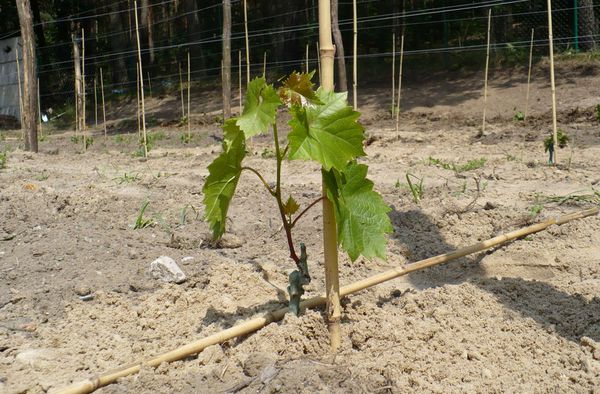Grapes are the decoration of every summer cottage. About its useful properties, we can talk to infinity. Without a doubt, it is unlikely that a person indifferent to this berry will be found. In order for the grapes to enjoy a rich harvest and excellent taste, it is necessary to plant the bushes in the ground with chugs or planting by grafting.
Table of contents
Choosing a good place for planting seedlings
When choosing a place to plant, you must consider the following factors:
- any place for growing grapes in the open field should well shined with sunlight and be protected from the wind;
- good shelter grapes serve as a wall of the house or a fence on the south side. In the cold period of time, this will give the grapes extra warmth and protect it from wind gusts;
- the soil should good water and airas well as rich in nutrients;
- grapes should not be planted near trees, as between them there will always be competition for nutrients;
- when planning the planting of grapes it is important to remember the advice that the distance between the bushes not less than 2.5 metersand aisle about 3 meters. This will allow the bushes to fully grow and develop. In addition, adherence to proper planting will avoid infection with fungal diseases.
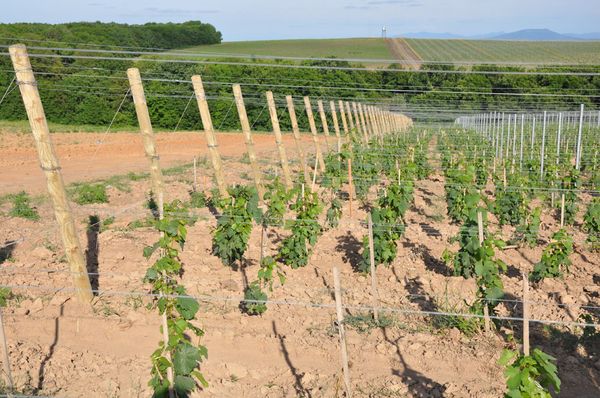
Benefits of the fall planting in open ground
Planting seedlings in the fall has several advantages:
- more varied selection of seedlings, as fairs for the sale of the most elite varieties are held in the autumn period;
- prices for planting material in order cheaper spring prices;
- the soil in the fall is sufficiently moist, which greatly facilitates the rooting and development of young seedlings;
- there is no need for storage, the risk of diseases accordingly decreases;
- the soil accumulates heat all summer, and then a long period of time gives this heat to the roots of the plant, despite the cold weather;
- growing seedlings during the cold period hardens the plant, thereby developing a lasting immunity. Subsequently, the autumn will easily endure lowering the temperature to -22 degrees;
- with the onset of spring, awakening and active growth immediately take place, thereby reduced susceptibility to diseases and pests.
There are also a number of shortcomings that also need to be considered:
- not all varieties tolerate an abundance of precipitation;
- damage of the root system by rodents is not excluded;
- is necessary take into account temperature drops, because late planting can cause the young vine to freeze out.
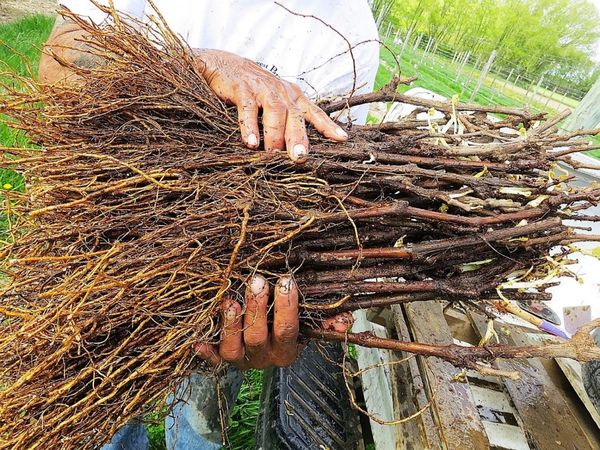
Ways of planting grapes in autumn
To carry out the autumn planting of grapes can be saplings and cuttings. To get a good harvest you need to choose the right seedlings.
To choose seedlings It follows the following criteria:
- Sapling trunk not less than 50 cm and have a brown color;
- Be sure to have one or more processes. The length of the shoot does not matter;
- The root system should be well developed and should have upper and lower nodes;
- Root Length - not less than 15 cm;
- The color of the roots is white, the root itself is wet;
- The seedling should not be in the sun;
- The color of the vine leaves should be saturated. If the leaves have a pale color, this indicates that the seedling is grown in a greenhouse. Such seedlings do not have hardening and may not survive the winter.
Planting seedlings - step by step instructions
Before planting, seedlings should be prepared according to the step-by-step instructions:
- Before landing it is necessary soak the seedlings in cold water for a day. You can do this even on the windowsill at home.You can add a root growth stimulator to the water, but this can be badly displayed on the vine with further cultivation;
- Further, having pulled out a seedling for reproduction from water, we carefully examine it, with sharp scissors we cut off the top of green mass, leaving only no more than 4 eyes.
- Trim the roots of the upper node completely, and shorten the roots of the lower node by 1 cm. This procedure is performed in order to stimulate growth;
- For the prevention of fungal diseases, before planting, treat seedlings with antifungal preparations. For these purposes, the drug "Dnoka".

Preparing a planting pit to plant a vine
Planting pits need to be prepared step by step two weeks before planting. When planting it is necessary to take into account that the vine loves fertile black soil. The width of the pit in diameter should be not less than 80 cmthe depth of the pit not less than 1 meter.
At the bottom of the pit pour layer expanded clay. It will serve as a drainage layer, and protect the roots from excess moisture. A tube is inserted into the drainage layer, with the help of which it will be possible to carry out basal watering and fertilizing the seedling.
Digging a hole requires the top layer of soil, constituting 1/3 of the excavated soil, to be folded separately. This soil will be used to prepare the nutrient mixture. In another pile, we fold the remaining soil. Next, you need to pour a layer of nutrient soil with a thickness of 40 cm.
The soil is prepared as follows:
- black soil - 5 buckets;
- ash - 1 liter;
- phosphate fertilizer — 150 grams;
- manure - 2 buckets.
These ingredients are well mixed and laid in a hole. After laying the soil we water and leave for two weeks for land shrinkage.
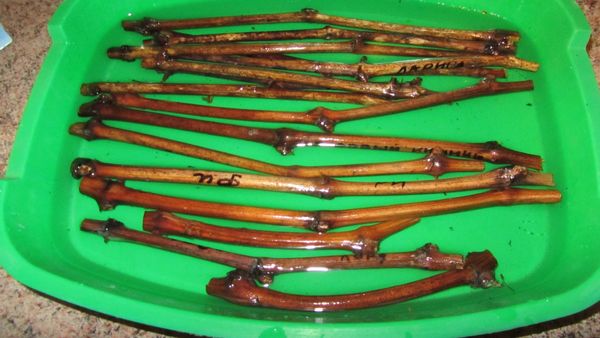
One day before planting is necessary soak the seedling in the honey solution. It will be a natural stimulator of root growth.
Proper landing distance and maintenance conditions
When planting important criteria are:
- depth of landing;
- how is the upper eye of the seedling;
- distance honey seedlings.
With this landing, the root penetration will be on 35-40 cm. This will be enough for the root not to become extinct. Having deepened a sapling, we fall asleep with the remains of soil dug out of a hole and mixed in advance with coarse sand. It is necessary to carry out one more nuance thanks to which the root system will develop well.
During planting, the roots are first lowered to the bottom, and then slightly raised. This will allow the roots to straighten well and take a natural position.
Roots must be located tilted 45 degrees. If you do not perform this procedure, the roots are deformed and die. Consequently, until new roots grow, the plant suspends its development and the sapling does not receive nutrients from the soil during this period.
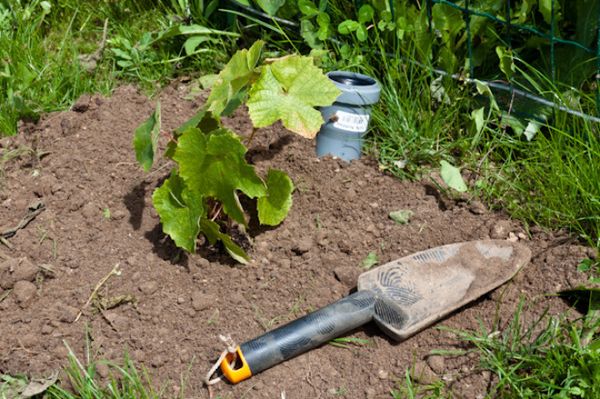
Then the seedling must be watered. Watering done once after landing. Water consumption per bush is from 20 to 30 liters. Watering is best done through the drainage tube.It is necessary in order to remove all air voids and thereby provide the roots with better contact with the ground.
After landing is necessary to grumble the landing pit can be done with the help of pine branches, straw or sawdust. Next to the seedling, it is necessary to drive a peg and tie a young shoot to it with a soft fabric cord - these are the basic rules of post-planting care.
Preparing for the winter
After planting, it is necessary to properly prepare the seedlings for the winter. When frost is necessary perform covering work. If grapes grow in a warm region, for example, in the Crimea or the Krasnodar Territory, then it will be enough to cover it with a layer of soil with a thickness of 30 to 50 cm.
So that the layer in the form of tubercle is not washed away by rain, it is covered with polyethylene. Polyethylene is strengthened from above with boards so that it will not be blown off by gusts of wind. After the snow falls, the grapes are covered with snow, which will be an additional protection against frost.
In colder regions, the warming of seedlings is suitable with great care. Their wrapped in polyethylene and laid in earthen tunnels. Top covered with pine branches, sawdust or hay.However, with the warming of seedlings the main thing is not to overdo it. The grapes, covered with such care when the warming occurs, can melt.
Another disadvantage of early harboring is that in the ground grapes can be damaged by rodents and harmful insects. Experienced winegrowers advise to cover the grapes after the onset of the first frost. Thus, the seedling will be hardened.
Autumn planting grapes cuttings
You can propagate the grapes by cuttings that are obtained in the process of autumn pruning. In the quality of cuttings left healthy shoots at the age of one yearthat have mustache and stepchildren removed, and who have at least three or four well-developed buds.
Soil should be wet. Planted cuttings better in the trenches. Trenches dig in advance.
The width and depth of the trench will be equal to the width of the spade (on the bayonet). Rows should be wide 40 cm. The bottom of the trench is covered with humus, the cuttings are planted at an angle to the southern part at a distance 15 cm apart. After planting, it is necessary to perform watering at room temperature.
Above the cuttings need to build 35-40 cm tall frame and pull polyethylene on it. In such a hothouse, seedlings will be protected from wind and frost and safely survive the winter.
In the spring, when the frosts pass and the shoots begin to appear on the cuttings, it is necessary to open the polyethylene for a while to air them. As soon as heat is established and there will be no threat of frost, the polyethylene must be removed.
If all the rules of planting have been observed, then a healthy, powerful vine will grow from cuttings, which will quickly adapt to temperature changes and easily endure wintering.
